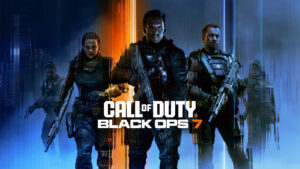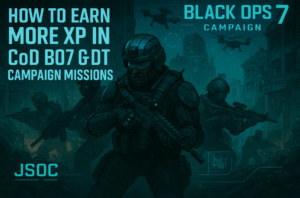When talking about the Call of Duty franchise, most players immediately think of blockbuster console titles like Modern Warfare or Black Ops. However, one of the most overlooked entries in the series is Call of Duty: World at War for the Nintendo DS, released alongside its console counterparts in November 2008. While scaled down for handheld play, this version of World at War managed to capture the intensity of World War II combat, delivering an ambitious mix of campaign missions, minigames, and even multiplayer features.
With COD BO7 rumored to push the series forward again, it’s worth revisiting this handheld experiment that paved the way for portable first-person shooters.
Gameplay Overview – Classic COD in Your Pocket
The DS version of World at War retained the familiar mechanics of the franchise but adapted them to Nintendo’s unique hardware.
- Controls: Movement was mapped to the D-pad, while the touch screen handled aiming, weapon switching, and reloading. Shoulder buttons were reserved for firing. The touchscreen also introduced quick access features—such as tapping to switch between hip fire and aiming down sights.
- Missions: The campaign spanned across the Pacific Theater, the Eastern Front, and the European Front, letting players experience the war through the eyes of multiple soldiers: USMC Private Rook, Soviet Private Dimarkurato, and SAS Private Owen Pasley.
- Game Modes: In addition to the story campaign, players could jump into Quick Play to replay missions, or tackle Challenge Mode, which required completing objectives under strict time limits—such as melee kills or grenade eliminations.
- Collectibles and Achievements: Hidden star-shaped items rewarded exploration, while in-game achievements incentivized skillful play.
Compared to its predecessor on DS (Call of Duty 4: Modern Warfare), World at War improved its visuals with better geometry, responsive movement, and more authentic iron sights rendered in 3D. Running at 30 FPS, it was one of the more polished shooters on the system.
Minigames – Breaking the Battlefield Routine
One of the DS version’s unique aspects was its reliance on touchscreen-based minigames, which brought variety to the campaign. Players had to:
- Defuse mines by carefully tracing wires.
- Send Morse code messages through timed tapping.
- Bandage wounded allies in the middle of firefights.
- Operate heavy artillery by rotating wheels to aim mortars and cannons.
Beyond these, vehicle missions stood out—parachuting into combat zones, manning anti-aircraft turrets, and controlling tanks gave the campaign more cinematic flair than expected for a handheld title.
Plot Breakdown – A Multi-National Campaign
Though simplified compared to the console versions, the DS story still covered multiple perspectives of World War II.
US Marine Campaign – The Pacific Theater
- Boot Camp to Makin Atoll: Players started as Private Rook, learning basic combat before storming Japanese fortifications.
- Peleliu Island Assault: Fighting through airfield defenses and cliffside artillery emplacements, the missions mirrored the brutal island-hopping warfare of the Pacific.
- Finale at Okinawa and Shuri Castle: The climax saw Rook manning anti-aircraft defenses before leading the charge to raise the American flag over the castle ruins.
SAS Campaign – The European Front
- Bomber Missions Over Holland: Private Dawkins began as a bombardier before being shot down, forcing him to regroup with paratroopers on the ground.
- Urban Warfare in the Rhineland: Dawkins’ story escalated into tank missions and defense operations, culminating in the destruction of German resistance.
Soviet Campaign – The Eastern Front
- Seelow Heights Offensive: Private Dimarkurato fought through entrenched German defenses, commanding artillery and tanks.
- Berlin Invasion: Missions escalated toward the Reichstag, blending street combat with a daring operation to secure nuclear research before the Soviets raised their banner in victory.
Multiplayer – Small but Functional
Despite hardware limitations, World at War on DS included multiplayer functionality:
- Online and Local Play: Up to four players could battle in deathmatch-style skirmishes.
- Modes: Four game types were available, though the DS lacked perks, killstreaks, or ranking systems.
- Missing Features: Unlike its console version, there was no Nazi Zombies mode—though later DS titles like Black Ops introduced it.
Why It Still Matters Before COD BO7
Although many fans have forgotten this portable entry, Call of Duty: World at War DS proved the franchise could adapt to smaller hardware without losing its core identity. It experimented with mechanics like touchscreen interactivity and minigames, which gave it a distinct personality compared to the console version.
With COD BO7 on the horizon, looking back at World at War DS shows just how far the series has evolved—from the constraints of the DS stylus to cutting-edge next-gen warfare. It reminds us that even handheld spinoffs played a role in shaping the identity of Call of Duty as a global franchise.
As the community gears up for COD BO7, many players are already exploring ways to enhance their multiplayer experience. Whether you’re revisiting the classic roots of the franchise or preparing for the battles ahead, joining the right matches can make a huge difference. For those looking to gain an edge or simply connect with skilled teammates, options to buy cod bo7 lobby are becoming a popular way to jump straight into the action. It’s a reminder that, just like in the days of World at War DS, the strength of the Call of Duty experience often comes from the battles we share with others.


